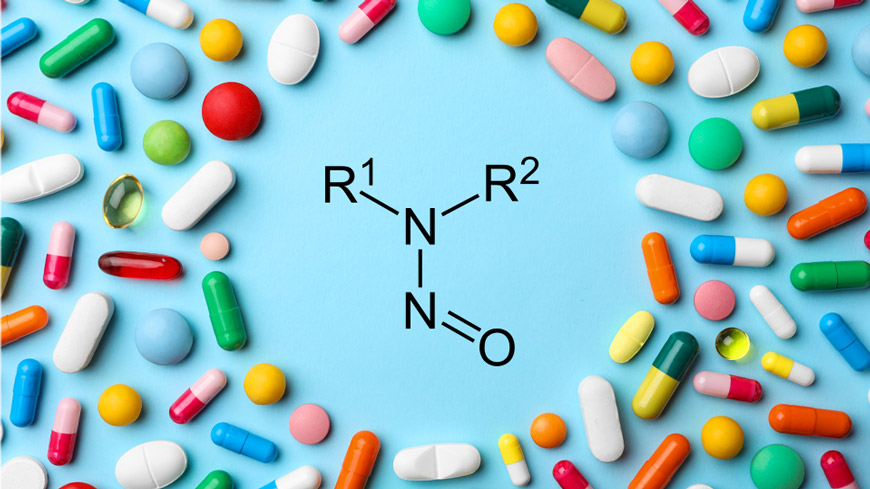Over the past few years, the texts of the European Pharmacopoeia (Ph. Eur.) have been adapted regularly to reflect the latest European regulatory requirements for N-nitrosamines.
This included adding a Production statement covering the risk of N-nitrosamine formation to the Ph. Eur.’s five “sartan” monographs (rapid implementation in April 2021), revising two major general monographs Substances for pharmaceutical use (2034) and Pharmaceutical preparations (2619) to align them with the European requirements, and elaborating a new general chapter, 2.5.42. N-Nitrosamines in active substances.
To date, the risk of contamination by specific N-nitrosamine impurities in individual monographs on active substances has been tackled in two different ways in the Ph. Eur., either by introducing a statement in the Production section of certain texts – as was the case for the “sartan” monographs – or by adding a specification in the Tests section of the monograph. No general recommendation for N-nitrosamine impurities existed in medicinal product monographs.
At its 176th session (20-21 June 2023), the European Pharmacopoeia Commission (EPC) reviewed its current approaches, taking into account the current set of texts on N-nitrosamines, and in particular the two general monographs, Substances for pharmaceutical use (2034) and Pharmaceutical preparations (2619), both of which now include a corresponding statement (see recently published Supplement 11.3). It was decided at the session to review the original strategy for N-nitrosamine control in individual monographs on both active substances and medicinal products.
Regarding active substances
As a result, the EPC recommended deleting the Production section covering N-nitrosamine impurities from individual monographs on active substances and avoiding the inclusion of such statements in new monographs in the future, since the general requirement for N-nitrosamines given in revised general monograph 2034 applies to all the ingredients within the given scope. This would avoid unnecessary repetition, ensure inter-monograph consistency and prevent the absence of such a statement in a monograph being misinterpreted as an absence of risk.
The EPC also proposed to define clear rules on when to add a specification for N-nitrosamine impurities in the Tests section of an active substance monograph. It was suggested this should apply only when the N-nitrosamine is a process-related impurity, i.e. generated during synthesis of the substance, or a degradation impurity arising from its storage. The test and limit would be included in an individual monograph if the impurity has been detected in several sources of the substance and once a limit approved by competent authorities or recommended by the Non-clinical Working Party (NcWP) becomes available. However, the EPC also recommended not to address the following types of potential N-nitrosamine contamination in the individual monograph as they are assumed to be covered elsewhere:
- impurities from manufacturing practices during the API synthesis (recovered or recycled materials, cross-contamination);
- an N-nitrosamine drug substance-related impurity (NDSRI), unless it is generated during synthesis of the active substance or is related to degradation of the active substance itself;
- potential risk of transformation into a nitrosamine (e.g. secondary amines).
Regarding medicinal products
For monographs on medicinal products, the EPC did not consider it appropriate to introduce a specification in the Tests section or a statement in the Production section, except in specific and justified cases, since the risk of N-nitrosamine formation depends to a great extent on the composition of the medicinal product and the conditions under which it is manufactured. The N-nitrosamines section of general monograph Pharmaceutical preparations (2619) is considered to address this risk appropriately.
Conclusion
The impact of the proposed strategy on already published individual Ph. Eur. monographs is detailed in the following table.
|
Monographs |
Reference |
Place of statement |
Revision |
|
Clopamide |
01/2017:1747 |
Production |
TECHNICAL |
|
Gliclazide |
07/2021:1524 |
Test |
NO |
|
Molsidomine |
01/2017:1701 |
Test |
NO |
|
Indapamide |
04/2022:1108 |
Test |
NO |
|
Trolamine |
01/2017:1577 |
Test |
NO |
|
Dalteparin sodium |
01/2008:1195 |
Production |
TECHNICAL |
|
Nadroparin calcium |
01/2008:1134 |
Test |
TECHNICAL |
|
Valsartan |
04/2021:2423 |
Production |
MINOR |
|
Candesartan cilexetil |
04/2021:2573 |
Production |
MINOR |
|
Olmesartan medoxomil |
04/2021:2600 |
Production |
MINOR |
|
Irbesartan |
04/2021:2465 |
Production |
MINOR |
|
Losartan potassium |
04/2021:2232 |
Production |
MINOR |
For those monographs that do not need to be revised, the specification could be reviewed if new data from regulatory authorities, the NcWP and/or manufacturers is brought to the attention of the EPC via national pharmacopoeia authorities or the EDQM. Similarly, other monographs would be reviewed in the light of new information and, if needed and justified, a specification for N-nitrosamines would be introduced.
Your opinion counts
If you have any major concerns about the proposed strategy, please share them with the Ph. Eur. Secretariat via the EDQM HelpDesk by the end of September 2023 at the latest for consideration by the EPC.
The EPC will take the final decision on its strategy for N-nitrosamine impurities in individual monographs at its November session.




